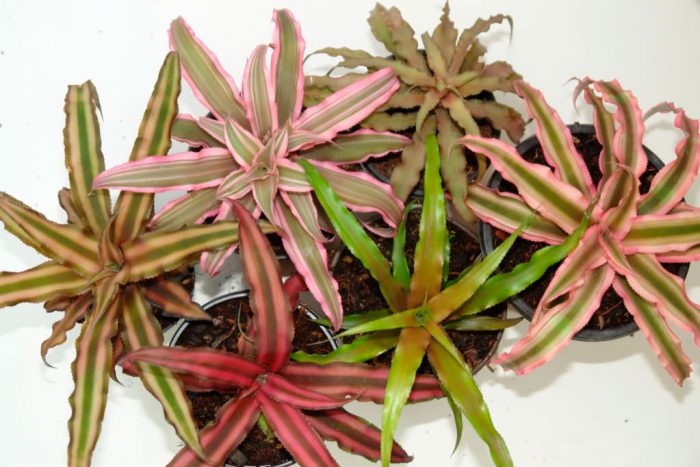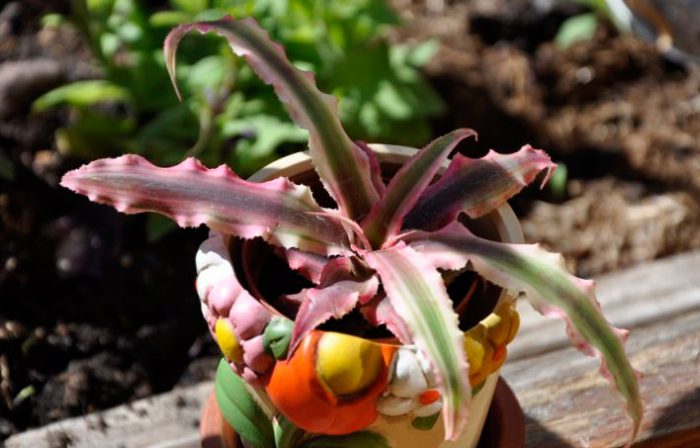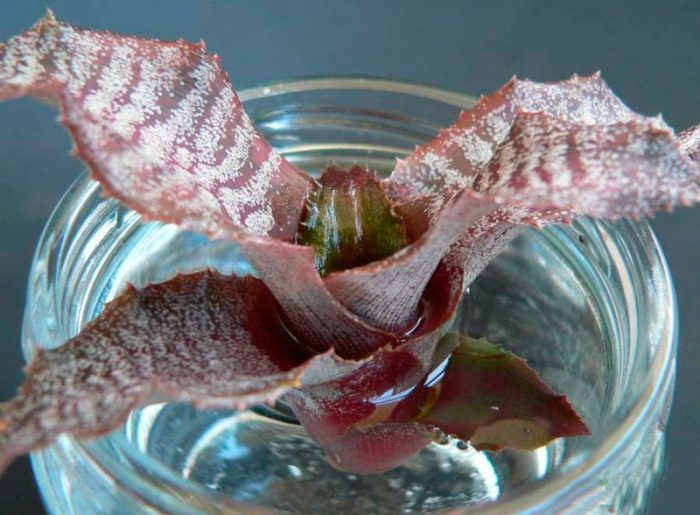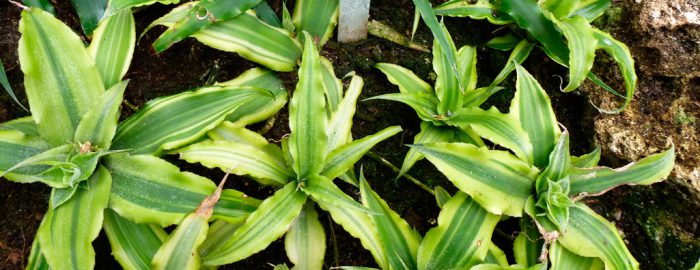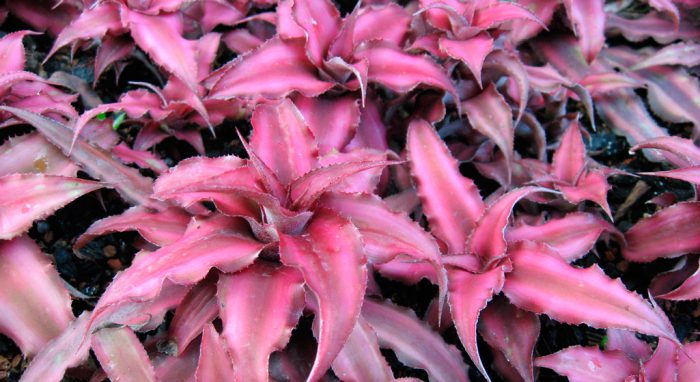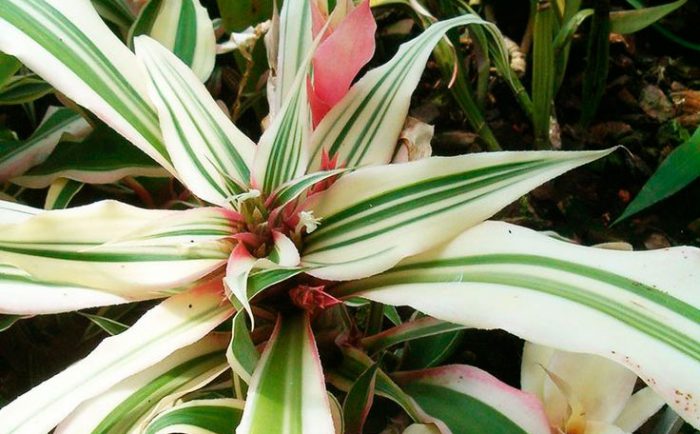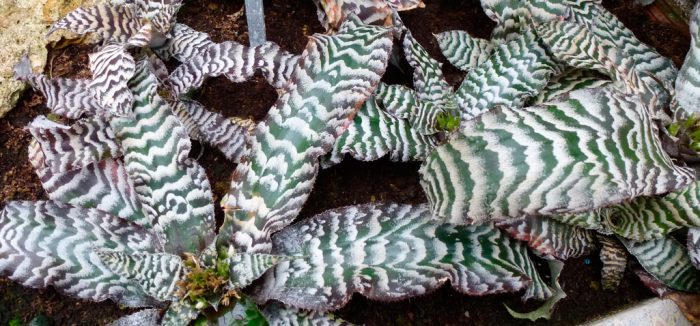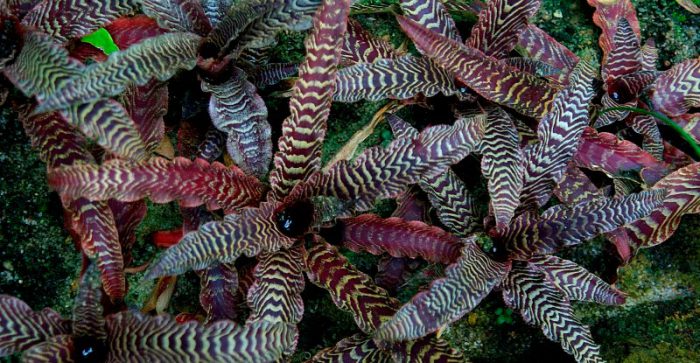Such a popular plant in home floriculture as cryptantus (Cryptanthus) is directly related to the bromeliad family (Bromeliaceae). This plant does not have a stem, and its elongated leaves are collected in a not very large, spectacular rosette. That is why this plant is also called “earth star". In natural conditions, it can be found in Eastern Brazil.
Quite long leaves, wide at the base, become narrower towards the end. They often have wavy edges. Foliage can be painted in different colors, namely, various shades of brown-red, white, green, pink or yellow. At home, species with patterned or striped leaves are often grown.
Small flowers, hidden in a leaf outlet. When the flowering ends, the mother rosette dies, but before this happens, many babies (daughter side shoots) appear near it.
Cryptanthus differs from the epiphytic members of its family in that it has well-developed roots and needs nutritious soil. It also has the smallest and most spectacular leaf rosettes. For cultivation, you can use ordinary flower pots, since this flower is not capricious, despite the fact that it needs high humidity.
It is recommended to place such a plant in indoor conditions in a semi-closed or closed glass container, for example, in a terrarium or florarium. It can also be supplemented with a miniature garden in a bottle, consisting of plants that love moisture.
Cryptantus home care
Illumination
It is a light-loving plant that prefers bright light. But at the same time it requires obligatory shading from the scorching midday sun in the summer. The plant feels fine in any light, but the more light, the brighter the pattern. In the cold season, the flower also needs good lighting. It is recommended to use fluorescent lamps for supplementary lighting.
Temperature regime
In summer, the air temperature should be between 22 and 24 degrees. In the cold season, a lower temperature of 18 to 20 degrees is suitable. When growing cryptanthus indoors, a temperature of 15 to 24 degrees is quite suitable.It is necessary to protect this plant from sudden temperature fluctuations, as well as from cold drafts.
Humidity
Needs high humidity. He needs frequent spraying, experienced flower growers advise placing the cryptanthus next to a humidifier. During the heating season, when the air humidity is low in the apartment, it is recommended to place the plants in the terrarium.
How to water
Watering should be moderate enough, as the root system is quite small and can rot easily. During the summer, the ground should be constantly moist, but not wet. Do not allow the earthen coma to dry out. In the autumn-winter period (when there is a dormant period in cryptantus), watering should be slightly reduced, but at the same time the substrate should always be slightly damp.
Top dressing
Top dressing is carried out during intensive growth once a month during the summer. For this, special fertilizers are used intended for bromeliads. In the cold season, feeding is not carried out.
How to transplant
Cryptantus practically does not need a transplant, only as needed, since its growth is extremely slow. A flower pot is chosen low, but rather wide. In the case when the plant is an adult, it may begin to bloom, and at this time it may need additional space for the emerging offshoots.
Earth laugh
The soil must be permeable to water to avoid liquid stagnation. A suitable soil mixture consists of sphagnum moss, humus, as well as leafy soil, pine bark and high peat, taken in a ratio of 1: 0.5: 1: 3: 1. You can also purchase a dredge for bromeliads. The height of the drainage layer is equal to the third part of the pot.
Reproduction methods
In room conditions, such a plant is propagated by lateral processes.
After the cryptanthus fades, it dies, but before that many children grow up around it. It is recommended to transplant them into pots separately after a couple of months, by which time a root should appear in young plants, and 3 or 4 leaves should grow. Having carefully separated the lateral process together with the roots, it is transplanted into a separate pot.
After transplanting, young plants need warmth (26-28 degrees). They also need high air humidity, and in order to provide it, they need to make a cap from a transparent bag. Remember to ventilate the cryptanthus every day by removing the hood for a while. After the foliage begins to grow actively, the flower can be looked after as an adult plant.
Possible problems
- The tips of the leaves dry - too low air humidity.
- Sluggish foliage and after watering nothing changes - the roots have rotted.
- Brownish specks on foliage - sunburns.
- Rot formation - cold draft or overflow.
Video review
Main types
Stemless Cryptanthus (Cryptanthus acaulis)
It is the most popular type for home cultivation. This herbaceous perennial plant has no stem or is very short. Pointed, narrow-lanceolate, leathery leaves have wavy edges. They can grow in length up to 20 centimeters. Small sharp teeth are present at the edges of the leaves. Often, green leaves have stripes of a lighter shade. There are varieties with green-pink leaves. His flowers are white.
Cryptanthus bivittatus
Its leaves are not so long (7-10 centimeters). A not very large leaf rosette (up to 15 centimeters in diameter) is rather dense. On the wavy edges of the leaves, small denticles are located. They are painted in a pale green color, and on their surface there are 2 longitudinal light stripes. There are varieties in which the foliage has a pink-red color, and their stripes are light or green. White flowers are rather inconspicuous. Perfect for a miniature garden in a glass vessel.
Cryptanthus bromelioides
Unlike other species, it has a distinguishable short trunk. Bright leaves are colored in various shades from copper-red to green. Their edges are serrated, wavy. As a rule, you can buy a variety of "Tricolor" in stores, on the leaves of which there are spectacular stripes of white, green, and also pink-red.
Cryptanthus zonatus
The leathery leaves have a spectacular transverse coloration. The leaves grow up to 20 centimeters long. A large number of transverse stripes, colored white or yellow, are placed on a dark green or just green background. There are very small white flowers. Thanks to him, a large number of varieties appeared, differing not only in the color of the leaves, but also in the transverse pattern.
Foster's Cryptanthus (Cryptanthus fosterianus)
It is similar to cross-striped, but its leaves are somewhat longer and not as wide. Their width is 4 centimeters and their length is from 30 to 40 centimeters. They are narrowed at the base. They have finely serrated, wavy edges. Above, the leaves are colored brownish-reddish and have zigzag stripes of a silvery hue. The lower part is densely covered with scales.

